Comparative Study on the Seismic Vulnerability of Continuous Bridges with Steel–Concrete Composite Girder and Reinforced Concrete Girder
Abstract
:1. Introduction
2. Fundamental Theory
2.1. Uncertainty
2.2. Seismic Vulnerability
3. Engineering Examples
3.1. Bridge Overview
3.2. Finite Element Modeling
3.3. Probabilistic Analysis of Seismic Demand
3.3.1. Probability Analysis Samples
3.3.2. Ground Motion Records
3.3.3. Nonlinear Dynamic Time History Analysis
3.4. Seismic Vulnerability of Components
3.4.1. Definition of Limit State
3.4.2. Vulnerability of Bridge Components
3.5. Seismic Vulnerability of Bridge System
4. Discussion
5. Conclusions
- (1)
- At the PGA of 0.1 g, the difference between the seismic vulnerabilities in the steel–concrete composite girder bridge and the reinforced concrete girder bridge was small. As the PGA increased, the seismic vulnerability of piers, abutments, and bearings in steel–concrete composite girder bridges gradually decreased compared to reinforced concrete girder bridges, particularly for piers. In the longitudinal direction, at the PGA of 0.3 g, the probabilities of moderate and serious damage of the pier of steel–concrete composite girder bridges were only 54.6% and 60.9%, respectively, of that of the reinforced concrete girder bridge. At the PGA of 0.4 g, the probabilities of serious and complete damage of the piers of steel–concrete composite girder bridges were 61.4% and 49.0%, respectively, of that of the reinforced concrete girder bridge. In the transverse direction, the seismic vulnerabilities of piers in the steel–concrete composite girder bridge were also significantly lower than those of the concrete girder bridge. Replacing the upper reinforced concrete girder with a steel–concrete composite girder significantly improved the seismic safety of the existing bridge piers under strong earthquake intensity.
- (2)
- The seismic vulnerabilities of abutments and bearings in steel–concrete composite girder bridges were lower than those of the concrete girder bridge. The four damage probabilities of the abutment in steel–concrete composite girder bridge were 10%–25% lower than those of the abutment in concrete girder bridge. The damage probabilities of the laminated bearings and the laminated bearings with PTFE in steel–concrete composite girder bridge were generally 80%–100% of those of the bearings in concrete girder bridge. Replacing the upper reinforced concrete girder with a steel–concrete composite girder can improve the seismic performance of abutments and bearings, although the effect was not as significant as that observed in piers.
- (3)
- The overall bridge system of the steel–concrete composite girder bridge exhibited lower probabilities of slight, moderate, serious, and complete damage states compared to the reinforced concrete girder bridge. In the longitudinal direction, the damage probabilities of the steel–concrete composite girder bridge system were generally 80%–97% of the reinforced concrete girder bridge system. In the transverse direction, the damage probabilities of the steel–concrete composite girder bridge system were generally 85%–95% of the reinforced concrete girder bridge system. Therefore, replacing the reinforced concrete girder with a steel–concrete composite girder reduced the seismic vulnerability of the bridge system by about 20%.
Author Contributions
Funding
Data Availability Statement
Conflicts of Interest
References
- Song, S.; Liu, J.; Qian, Y.J.; Zhang, F.; Wu, G. Dependence analysis on the seismic demands of typical components of a concrete continuous girder bridge with the copula technique. Adv. Struct. Eng. 2018, 21, 1826–1839. [Google Scholar] [CrossRef]
- Zhou, T.; Li, A.Q. Seismic fragility assessment of highway bridges using D-vine copulas. Bull. Earthq. Eng. 2019, 17, 927–955. [Google Scholar] [CrossRef]
- Nie, J.G.; Wang, J.J.; Gou, S.K.; Zhu, Y.Y.; Fan, J.S. Technological development and engineering applications of novel steel-concrete composite structures. Front. Struct. Civ. Eng. 2019, 13, 1–14. [Google Scholar] [CrossRef]
- Suwaed, A.S.H.; Karavasilis, T.L. Demountable steel-concrete composite beam with full-interaction and low degree of shear connection. J. Constr. Steel Res. 2020, 171, 106152. [Google Scholar] [CrossRef]
- De Angelis, A.; Pecce, M.R.; Logorano, G. Evaluation of the plastic hinge length of steel-concrete composite beams under hogging moment. Eng. Struct. 2019, 191, 674–685. [Google Scholar] [CrossRef]
- Gao, Q.F.; Zhang, K.; Wang, T.; Peng, W.K.; Liu, C.Q. Numerical investigation of the dynamic responses of steel-concrete girder bridges subjected to moving vehicular loads. Meas. Control. 2021, 54, 465–484. [Google Scholar] [CrossRef]
- Nicoletti, R.S.; Rossi, A.; de Souza, A.S.C.; Martins, C.H. Numerical assessment of effective width in steel-concrete composite box girder bridges with partial interaction. Eng. Struct. 2021, 239, 112333. [Google Scholar] [CrossRef]
- Nie, X.; Fan, J.S.; Shi, Y.J. Seismic Behavior of A New Type of Steel-Concrete Composite Rigid Connection. J. Earthq. Tsunami. 2011, 5, 283–296. [Google Scholar] [CrossRef]
- Shao, X.D.; Deng, L.; Cao, J.H. Innovative steel-UHPC composite bridge girders for long-span bridges. Front. Struct. Civ. Eng. 2019, 13, 981–989. [Google Scholar] [CrossRef]
- Boller, C.; Starke, P.; Dobmann, G.; Kuo, C.M.; Kuo, C.H. Approaching the assessment of ageing bridge infrastructure. Smart Struct. Syst. 2015, 15, 593–608. [Google Scholar] [CrossRef]
- Beng, S.S.; Matsumoto, T. Survival analysis on bridges for modeling bridge replacement and evaluating bridge performance. Struct. Infrastruct. Eng. 2012, 8, 251–268. [Google Scholar] [CrossRef]
- Khan, M.S.A.; Etonyeaku, L.C.; Kabir, G.; Billah, M.; Dutta, S. Bridge infrastructure resilience assessment against seismic hazard using Bayesian best worst method. Can. J. Civ. Eng. 2022, 49, 1669–1685. [Google Scholar] [CrossRef]
- Qi, J.J.; Ye, Y.N.; Huang, Z.; Lv, W.R.; Zhou, W.B.; Liu, F.C.; Wu, J.D. Experimental Study and Theoretical Analysis of Steel-Concrete Composite Box Girder Bending Moment-Curvature Restoring Force. Sustainability 2023, 15, 6585. [Google Scholar] [CrossRef]
- Lin, Y.Z.; Bi, K.M.; Zong, Z.H.; Hao, H.; Lin, J.; Chen, Y.Y. Seismic Performance of Steel-Concrete Composite Rigid-Frame Bridge: Shake Table Test and Numerical Simulation. J. Bridge Eng. 2020, 25, 04020032. [Google Scholar] [CrossRef]
- Han, Q.; Du, X.L.; Liu, J.B.; Li, Z.X.; Li, L.Y.; Zhao, J.F. Seismic damage of highway bridges during the 2008 Wenchuan earthquake. Earthq. Eng. Eng. Vib. 2009, 8, 263–273. [Google Scholar] [CrossRef]
- Cao, S.S.; Jiang, L.Z.; Wei, B. Numerical and experimental investigations on the Park-Ang damage index for high-speed railway bridge piers with flexure failures. Eng. Struct. 2019, 201, 109851. [Google Scholar] [CrossRef]
- Mahboubi, S.; Shiravand, M.R. Failure assessment of skew RC bridges with FRP piers based on damage indices. Eng. Fail Anal. 2019, 99, 153–168. [Google Scholar] [CrossRef]
- Sun, Z.G.; Wang, D.S.; Guo, X.; Si, B.J.; Huo, Y. Lessons Learned from the Damaged Huilan Interchange in the 2008 Wenchuan Earthquake. J. Bridge Eng. 2012, 17, 15–24. [Google Scholar] [CrossRef]
- Song, S.; Tian, Z.; Zhao, Z.Y.; Li, X.; Zhao, J.F.; Xu, B.S. Experimental Study on Seismic Performance of CFRP-Strengthened Recycled Concrete Columns with Different Levels of Seismic Damage. Buildings 2023, 13, 1470. [Google Scholar] [CrossRef]
- Tazarv, M.; Sjurseth, T.; Greeneway, E.; Hart, K.; LaVoy, M.; Wehbe, N. Experimental Studies on Seismic Performance of Mechanically Spliced Precast Bridge Columns. J. Bridge Eng. 2022, 27, 04022102. [Google Scholar] [CrossRef]
- Chen, L.; Zhang, Y.A.; Zuo, R.; Yang, D.H.; Xiang, N.L. Experimental Study on Seismic Performance of External Socket Precast Bridge Pier-Footing Connections for Rapid Postearthquake Replacement. J. Bridge Eng. 2024, 29, 04024020. [Google Scholar] [CrossRef]
- Shi, F.; Wang, D.S.; Tong, L.; Tang, W.J. Numerical simulation on seismic pounding damage in a simply-supported steel bridge. Heliyon 2023, 9, e22297. [Google Scholar] [CrossRef]
- Wang, J.; Li, F.Y. Numerical Simulation Analysis of the Seismic Performance of Precast Bridge Piers. Math. Probl. Eng. 2022, 2022, 1–11. [Google Scholar] [CrossRef]
- Tubaldi, E.; Barbato, M.; Dall’Asta, A. Influence of Model Parameter Uncertainty on Seismic Transverse Response and Vulnerability of Steel-Concrete Composite Bridges with Dual Load Path. J. Struct. Eng. 2012, 138, 363–374. [Google Scholar] [CrossRef]
- Orcesi, A.; Cremona, C.; Ta, B. Optimization of Design and Life-Cycle Management for Steel-Concrete Composite Bridges. Struct. Eng. Int. 2018, 28, 185–195. [Google Scholar] [CrossRef]
- Matos, J.C.; Moreira, V.N.; Valente, I.B.; Cruz, P.J.S.; Neves, L.C.; Galvao, N. Probabilistic-based assessment of existing steel-concrete composite bridges Application to Sousa River Bridge. Eng. Struct. 2019, 181, 95–110. [Google Scholar] [CrossRef]
- Liu, Y.; Paolacci, F.; Lu, D.G. Seismic fragility of a typical bridge using extrapolated experimental damage limit states. Earthq. Struct. 2017, 13, 599–611. [Google Scholar] [CrossRef]
- Soleimani, F.; Mangalathu, S.; DesRoches, R. A comparative analytical study on the fragility assessment of box-girder bridges with various column shapes. Eng. Struct. 2017, 153, 460–478. [Google Scholar] [CrossRef]
- Shekhar, S.; Ghosh, J.; Ghosh, S. Impact of Design Code Evolution on Failure Mechanism and Seismic Fragility of Highway Bridge Piers. J. Bridge Eng. 2020, 25, 04019140. [Google Scholar] [CrossRef]
- Stefanidou, S.P.; Kappos, A.J. Methodology for the development of bridge-specific fragility curves. Earthq. Eng. Struct. Dyn. 2017, 46, 73–93. [Google Scholar] [CrossRef]
- Nielson, B.G.; DesRoches, R. Seismic fragility methodology for highway bridges using a component level approach. Earthq. Eng. Struct. Dyn. 2007, 36, 823–839. [Google Scholar] [CrossRef]
- Song, S.; Wu, Y.H.; Wang, S.; Lei, H.G. Important measure analysis of uncertainty parameters in bridge probabilistic seismic demands. Earthq. Struct. 2022, 22, 157–168. [Google Scholar] [CrossRef]
- Naseri, A.; Roshan, A.M.; Pahlavan, H.; Amiri, G.G. Numerical Analysis and Vulnerability Assessment of Horizontally Curved Multiframe RC Box-Girder and CFRP Retrofitting of Existing Bridges. Asce.-Asme. J. Risk Uncertain. Eng. Syst. Part A-Civ. Eng. 2022, 8, 157. [Google Scholar] [CrossRef]
- Cornell, C.A.; Jalayer, F.; Hamburger, R.O.; Foutch, D.A. Probabilistic basis for 2000 SAC federal emergency management agency steel moment frame guidelines. J. Struct. Eng. 2002, 128, 526–533. [Google Scholar] [CrossRef]
- Park, C.; Kim, N.H.; Haftka, R.T. The effect of ignoring dependence between failure modes on evaluating system reliability. Struct. Multidiscip. Optim. 2015, 52, 251–268. [Google Scholar] [CrossRef]
- Song, S.; Qian, Y.J.; Liu, J.; Xie, X.R.; Wu, G. Time-variant fragility analysis of the bridge system considering time-varying dependence among typical component seismic demands. Earthq. Eng. Eng. Vib. 2019, 18, 363–377. [Google Scholar] [CrossRef]
- Zhu, Z.; Quiel, S.E.; Khorasani, N.E. Bivariate structural-fire fragility curves for simple-span overpass bridges with composite steel plate girders. Struct. Saf. 2023, 100, 363–377. [Google Scholar] [CrossRef]
- Zhong, J.; Jiang, L.; Pang, Y.; Yuan, W. Near-fault seismic risk assessment of simply supported bridges. Earthq. Spectra 2020, 100, 102294. [Google Scholar] [CrossRef]
- Shekhar, S.; Ghosh, J. A metamodeling based seismic life-cycle cost assessment framework for highway bridge structures. Reliab. Eng. Syst. Saf. 2020, 195, 1645–1669. [Google Scholar] [CrossRef]
- Wu, W.P.; Li, L.F.; Shao, X.D. Seismic Assessment of Medium-Span Concrete Cable-Stayed Bridges Using the Component and System Fragility Functions. J. Bridge Eng. 2016, 21, 04016027. [Google Scholar] [CrossRef]
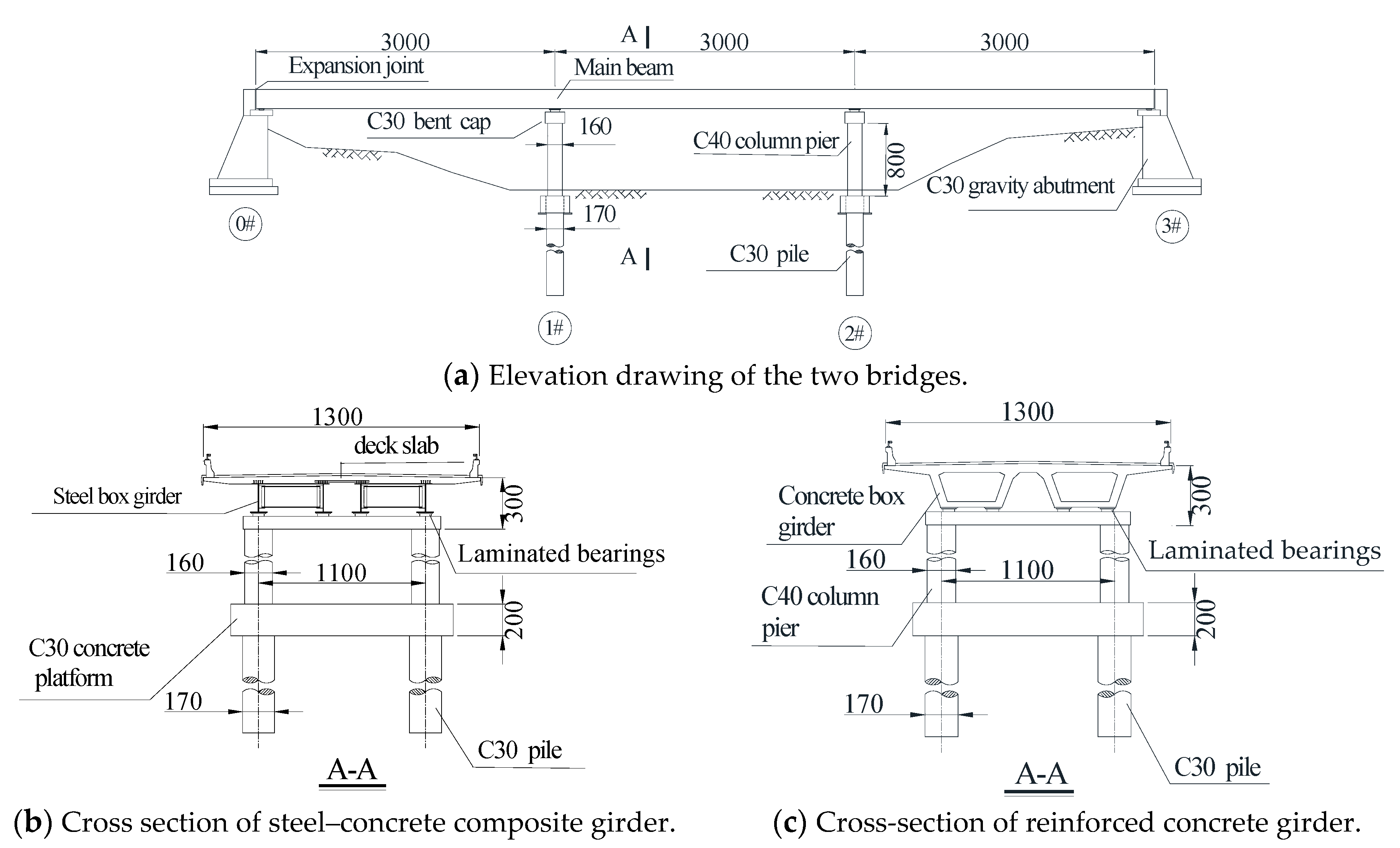
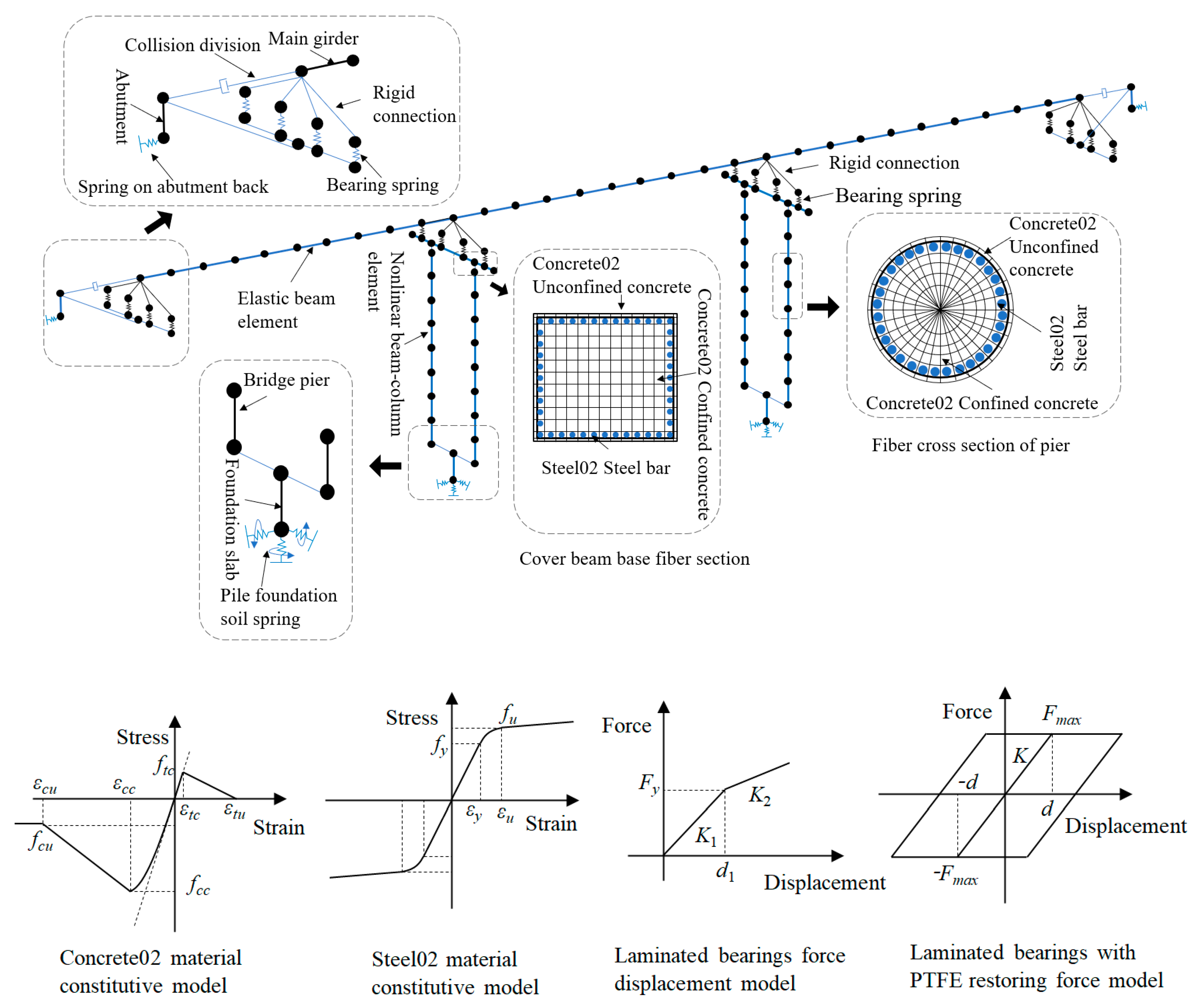



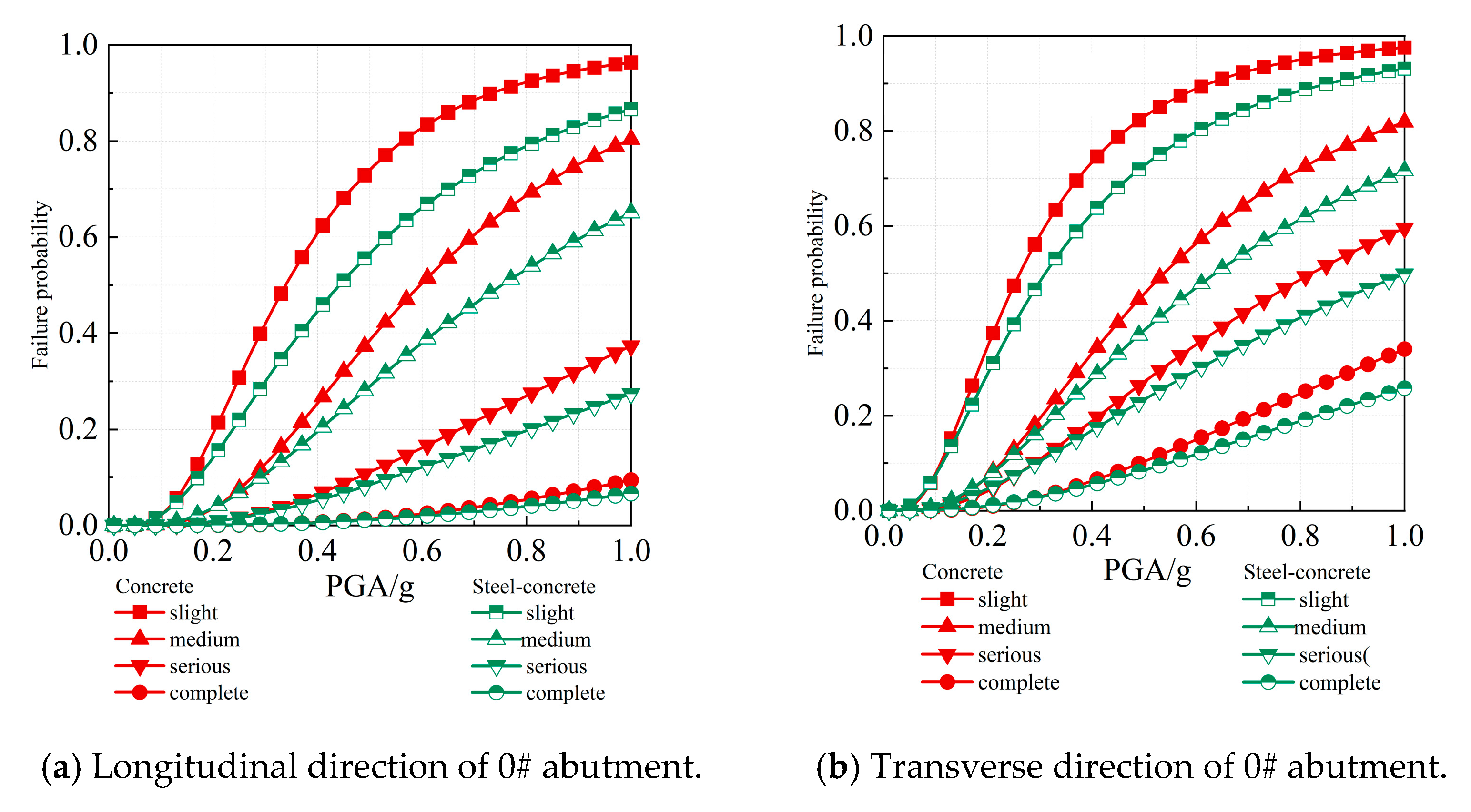
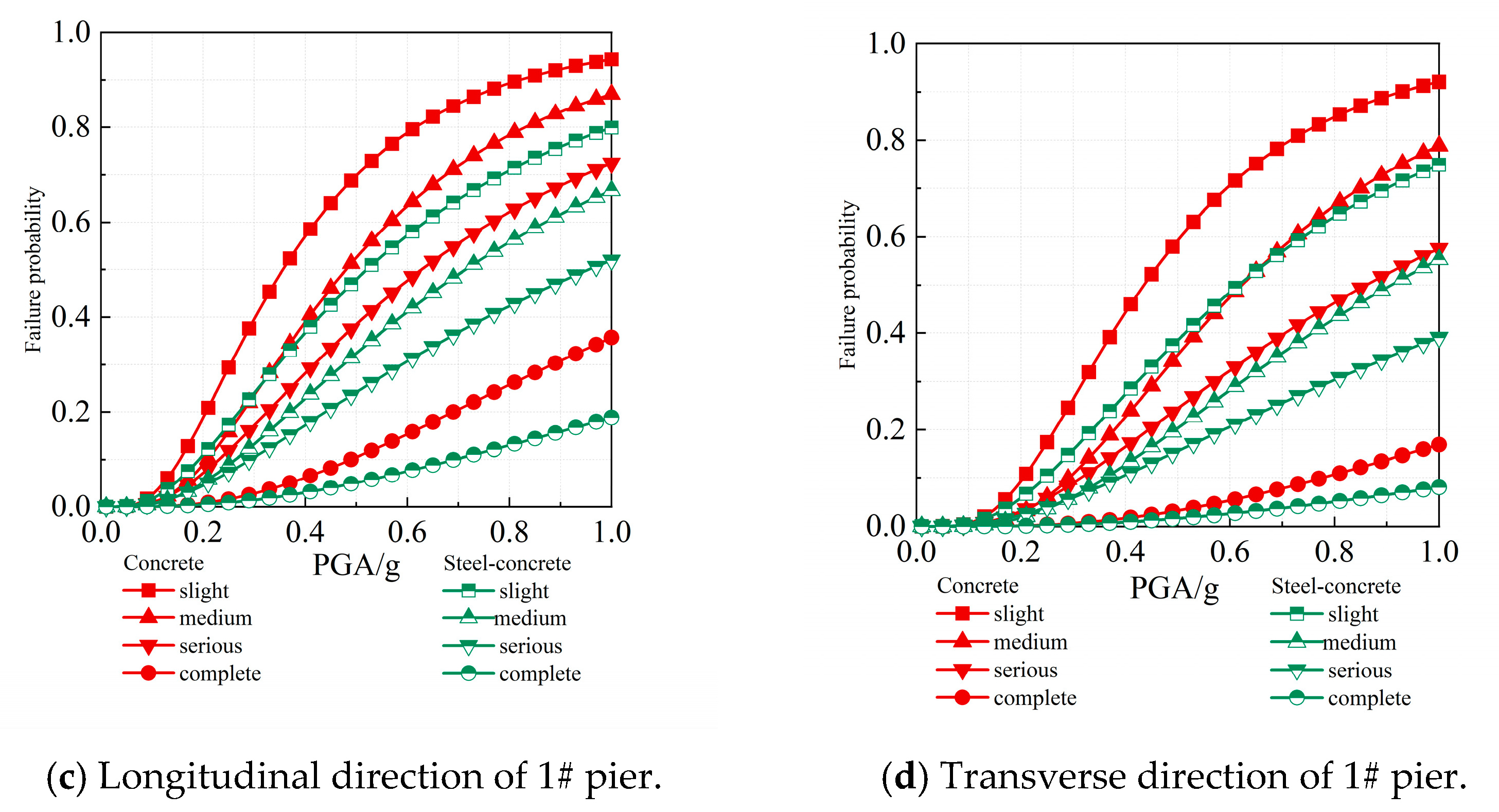
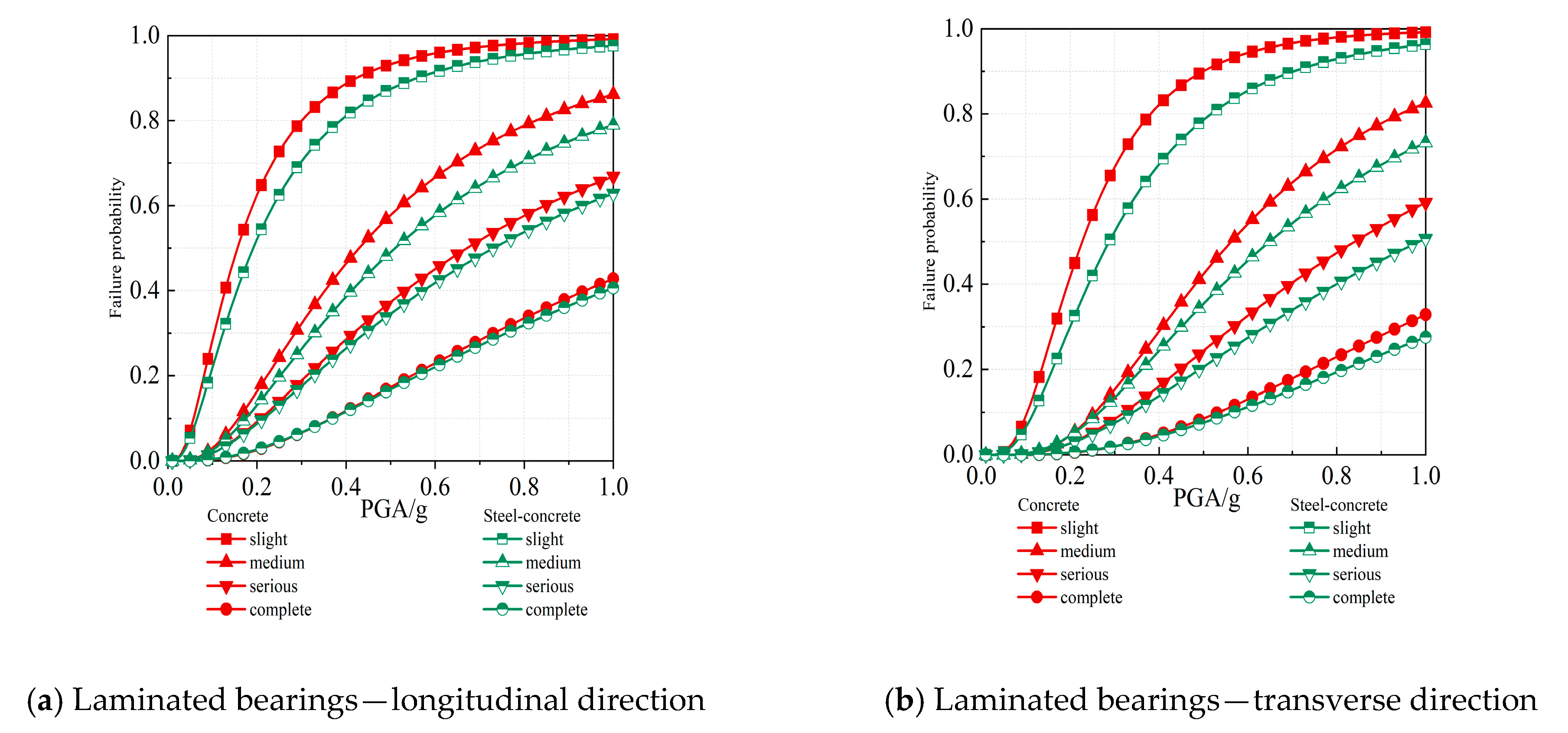



| Uncertainty Parameters | Distribution Patterns | Mean Values | Coefficients of Variation |
|---|---|---|---|
| Compressive strength of concrete/MPa | Normal distribution | 40.0 | 0.12 |
| Yield strength of steel bar/MPa | Lognormal distribution | 335.0 | 0.05 |
| Ultimate strength of steel bar/MPa | Lognormal distribution | 420.0 | 0.05 |
| Upper structure mass of steel–concrete composite bridge/(kN/m3) | Normal distribution | 23.87 | 0.10 |
| Upper structure mass of concrete bridge/(kN/m3) | Normal distribution | 30.61 | 0.10 |
| Damping ratio | Normal distribution | 0.05 | 0.20 |
| Concrete cover depth/mm | Normal distribution | 35.0 | 0.20 |
| Components | lna | b | β | p | R2 | |||||
|---|---|---|---|---|---|---|---|---|---|---|
| Longitudinal | Transverse | Longitudinal | Transverse | Longitudinal | Transverse | Longitudinal | Transverse | Longitudinal | Transverse | |
| 0# Abutment | 4.19 | 5.10 | 0.85 | 0.79 | 0.58 | 0.58 | 1.58 × 10−19 | 1.21 × 10−21 | 0.54 | 0.61 |
| 1# Pier | 0.67 | 0.44 | 0.87 | 0.71 | 0.63 | 0.45 | 1.25 × 10−21 | 1.52 × 10−25 | 0.61 | 0.67 |
| 2# Pier | 0.67 | 0.44 | 0.87 | 0.71 | 0.63 | 0.45 | 1.27 × 10−21 | 1.79 × 10−25 | 0.61 | 0.67 |
| 3# Abutment | 4.22 | 5.10 | 0.86 | 0.79 | 0.64 | 0.58 | 1.47 × 10−19 | 2.32 × 10−21 | 0.52 | 0.60 |
| 0# Bearing | 4.74 | 4.63 | 0.90 | 0.85 | 0.47 | 0.54 | 1.14 × 10−19 | 1.39 × 10−25 | 0.58 | 0.67 |
| 1# Bearing | 5.05 | 4.71 | 0.94 | 0.97 | 0.74 | 0.63 | 2.11 × 10−19 | 1.06 × 10−24 | 0.56 | 0.66 |
| 2# Bearing | 5.05 | 4.71 | 0.94 | 0.97 | 0.74 | 0.62 | 2.10 × 10−19 | 6.54 × 10−25 | 0.56 | 0.66 |
| 3# Bearing | 4.69 | 4.70 | 0.88 | 0.87 | 0.51 | 0.55 | 2.40 × 10−18 | 3.66 × 10−25 | 0.51 | 0.67 |
| Components | lna | b | β | p | R2 | |||||
|---|---|---|---|---|---|---|---|---|---|---|
| Longitudinal | Transverse | Longitudinal | Transverse | Longitudinal | Transverse | Longitudinal | Transverse | Longitudinal | Transverse | |
| 0# Abutment | 4.38 | 5.20 | 0.90 | 0.96 | 0.49 | 0.60 | 2.08 × 10−23 | 1.47 × 10−25 | 0.64 | 0.66 |
| 1# Pier | 1.04 | 0.70 | 1.01 | 0.84 | 0.61 | 0.43 | 9.08 × 10−27 | 5.83 × 10−32 | 0.69 | 0.61 |
| 2# Pier | 1.04 | 0.70 | 1.01 | 0.84 | 0.61 | 0.43 | 9.82 × 10−27 | 5.42 × 10−32 | 0.69 | 0.61 |
| 3# Abutment | 4.41 | 5.20 | 0.89 | 0.96 | 0.49 | 0.60 | 5.95 × 10−23 | 1.28 × 10−25 | 0.63 | 0.64 |
| 0# Bearing | 4.66 | 5.00 | 0.98 | 0.88 | 0.46 | 0.48 | 4.16 × 10−24 | 1.22 × 10−29 | 0.67 | 0.73 |
| 1# Bearing | 4.97 | 4.78 | 0.91 | 1.01 | 0.66 | 0.57 | 1.47 × 10−21 | 7.31 × 10−29 | 0.76 | 0.72 |
| 2# Bearing | 4.97 | 4.76 | 0.91 | 1.00 | 0.66 | 0.57 | 1.46 × 10−21 | 1.46 × 10−28 | 0.76 | 0.72 |
| 3# Bearing | 4.63 | 4.97 | 0.86 | 0.87 | 0.45 | 0.49 | 2.75 × 10−23 | 3.98 × 10−29 | 0.67 | 0.72 |
| Components | PGA/g | Slight Damage | Moderate Damage | Serious Damage | Complete Damage | |||||||||
|---|---|---|---|---|---|---|---|---|---|---|---|---|---|---|
| RC | SC | Ratio | RC | SC | Ratio | RC | SC | Ratio | RC | SC | Ratio | |||
| 1# Pier | Longitudinal | 0.2 | 18.8% | 11.0% | 58.4% | 9.0% | 5.1% | 57.1% | 7.1% | 4.5% | 63.3% | 0.8% | 0.4% | 56.6% |
| 0.3 | 39.6% | 24.0% | 60.5% | 23.6% | 13.3% | 56.4% | 17.2% | 10.5% | 60.9% | 2.8% | 1.4% | 51.1% | ||
| 0.4 | 57.1% | 36.8% | 64.4% | 39.0% | 22.9% | 58.6% | 28.2% | 17.3% | 61.4% | 6.2% | 3.0% | 49.0% | ||
| Transverse | 0.2 | 9.4% | 5.9% | 62.6% | 2.7% | 1.8% | 65.1% | 3.2% | 2.4% | 74.6% | 0.1% | 0.1% | 69.2% | |
| 0.3 | 26.4% | 15.8% | 59.9% | 10.8% | 6.2% | 57.2% | 9.0% | 6.0% | 66.8% | 0.6% | 0.4% | 58.7% | ||
| 0.4 | 44.3% | 27.4% | 61.8% | 22.7% | 12.7% | 56.1% | 16.5% | 10.6% | 64.2% | 1.7% | 0.9% | 53.0% | ||
| 0# Abutment | Longitudinal | 0.2 | 19.2% | 14.1% | 73.8% | 3.6% | 3.5% | 97.5% | 0.8% | 0.8% | 96.4% | 0.1% | 0.0% | 80.0% |
| 0.3 | 42.0% | 30.0% | 71.3% | 12.8% | 10.6% | 83.1% | 3.0% | 2.6% | 86.9% | 0.2% | 0.2% | 90.9% | ||
| 0.4 | 60.8% | 44.7% | 73.4% | 25.5% | 19.6% | 77.0% | 6.5% | 5.2% | 79.8% | 0.6% | 0.6% | 93.4% | ||
| Transverse | 0.2 | 34.7% | 28.9% | 83.3% | 7.3% | 7.1% | 98.2% | 4.7% | 4.2% | 89.7% | 1.0% | 0.9% | 86.0% | |
| 0.3 | 58.0% | 48.3% | 83.2% | 19.5% | 17.0% | 87.4% | 10.9% | 10.4% | 96.0% | 3.0% | 2.9% | 96.3% | ||
| 0.4 | 73.4% | 62.6% | 85.3% | 33.1% | 27.8% | 84.0% | 18.9% | 16.9% | 89.5% | 6.3% | 5.4% | 86.9% | ||
| Components | PGA/g | Slight Damage | Moderate Damage | Serious Damage | Complete Damage | |||||||||
|---|---|---|---|---|---|---|---|---|---|---|---|---|---|---|
| RC | SC | Ratio | RC | SC | Ratio | RC | SC | Ratio | RC | SC | Ratio | |||
| Laminated bearings | Longitudinal direction | 0.2 | 62.5% | 52.1% | 83.3% | 16.3% | 13.1% | 80.6% | 9.2% | 8.8% | 95.0% | 2.7% | 2.6% | 94.9% |
| 0.3 | 79.9% | 70.4% | 88.1% | 32.2% | 26.3% | 81.5% | 18.9% | 17.6% | 93.2% | 6.7% | 6.7% | 99.3% | ||
| 0.4 | 88.7% | 81.1% | 91.4% | 46.4% | 38.6% | 83.2% | 28.5% | 26.4% | 92.6% | 11.8% | 11.6% | 98.3% | ||
| Transverse direction | 0.2 | 41.8% | 30.1% | 71.9% | 4.6% | 4.6% | 98.7% | 2.8% | 2.7% | 97.5% | 0.6% | 0.5% | 87.3% | |
| 0.3 | 67.5% | 52.4% | 77.6% | 15.3% | 13.4% | 87.6% | 8.5% | 7.5% | 89.1% | 2.1% | 2.0% | 94.8% | ||
| 0.4 | 82.2% | 68.2% | 83.0% | 28.9% | 24.4% | 84.2% | 16.1% | 13.8% | 85.8% | 4.8% | 4.4% | 92.5% | ||
| Laminated bearings with PTFE | Longitudinal direction | 0.2 | 20.5% | 14.9% | 72.9% | 1.6% | 1.4% | 86.0% | 1.2% | 1.2% | 96.7% | 0.2% | 0.1% | 76.5% |
| 0.3 | 47.5% | 36.4% | 76.6% | 8.2% | 6.4% | 78.1% | 4.8% | 4.2% | 87.4% | 0.8% | 0.8% | 95.1% | ||
| 0.4 | 68.3% | 55.6% | 81.5% | 19.8% | 15.2% | 76.6% | 10.5% | 8.8% | 83.7% | 2.3% | 2.2% | 96.4% | ||
| Transverse direction | 0.2 | 41.8% | 33.7% | 80.6% | 6.9% | 5.6% | 80.1% | 2.9% | 2.2% | 76.0% | 0.7% | 0.6% | 84.9% | |
| 0.3 | 67.4% | 56.6% | 84.0% | 20.5% | 15.7% | 76.4% | 8.4% | 6.2% | 74.0% | 2.5% | 2.0% | 78.3% | ||
| 0.4 | 82.0% | 71.9% | 87.7% | 36.0% | 27.7% | 76.8% | 15.5% | 11.5% | 73.8% | 5.5% | 4.2% | 76.0% | ||
Disclaimer/Publisher’s Note: The statements, opinions and data contained in all publications are solely those of the individual author(s) and contributor(s) and not of MDPI and/or the editor(s). MDPI and/or the editor(s) disclaim responsibility for any injury to people or property resulting from any ideas, methods, instructions or products referred to in the content. |
© 2024 by the authors. Licensee MDPI, Basel, Switzerland. This article is an open access article distributed under the terms and conditions of the Creative Commons Attribution (CC BY) license (https://creativecommons.org/licenses/by/4.0/).
Share and Cite
Xu, B.; Sun, C.; Song, S.; Zhang, X.; Zhao, B.; Zhang, W. Comparative Study on the Seismic Vulnerability of Continuous Bridges with Steel–Concrete Composite Girder and Reinforced Concrete Girder. Buildings 2024, 14, 1768. https://doi.org/10.3390/buildings14061768
Xu B, Sun C, Song S, Zhang X, Zhao B, Zhang W. Comparative Study on the Seismic Vulnerability of Continuous Bridges with Steel–Concrete Composite Girder and Reinforced Concrete Girder. Buildings. 2024; 14(6):1768. https://doi.org/10.3390/buildings14061768
Chicago/Turabian StyleXu, Baishun, Chuanzhi Sun, Shuai Song, Xuening Zhang, Bin Zhao, and Wenhao Zhang. 2024. "Comparative Study on the Seismic Vulnerability of Continuous Bridges with Steel–Concrete Composite Girder and Reinforced Concrete Girder" Buildings 14, no. 6: 1768. https://doi.org/10.3390/buildings14061768






